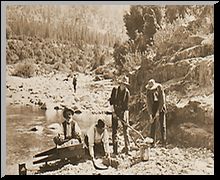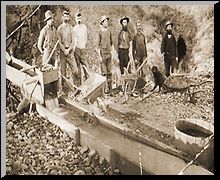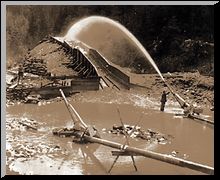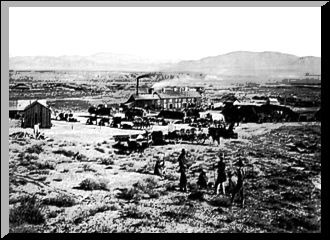Best Viewed in 800x640 using Internet Explorer
Gold Mining Terminology
A diggings - as the word shows, is one of those spots
where gravel has been dug and sifted in search for the
yellow treasure. (The word placer and diggings, means
one and the same thing.)
Assay A test of ores by chemical methods to determine the amount of precious
metals they contain.
Carbon in pulp (CIP) - The name of the process by which gold and silver are
liberated from the ore. The gold and silver are dissolved in large tanks and
then adsorbed onto carbon granules
Claim monuments - A pile of rocks about three feet in diameter and two feet
high, topped with a locations stick that had the name of the mine and the
finder. Inside the pile of rock would be a tin setting forth the conditions
of the claim, so many days to do work, and measure of his land area, and time
enough to file the record at the county seat.
Float - Mineral rich ore (a rock) that had been dislodged from its source
and was moved by nature. A prospector would try to locate the source of
this rock and then stake a claim.
Placer gold, or free gold was supposedly washed into the
creeks and gullies during the alluvial age, but a placer
is sometimes formed by erosion also. The gold
generally lies thickest on bedrock and is known as
paystreak. The gravel or wash is found in depths
ranging from a few inches to three or four hundred
feet.
Placer Mining - A gravely sandbank, generally located in
an ancient river bed, where loose gold is usually found.
Troy ounce - system of weight employed in Great Britain
and the U.S., used for the weighing of precious metals.
The name is derived from the city of Troyes, France,
where the system originated. The troy pound is 340 g
(12 oz), and the troy ounce is the basis of apothecary
weight.
Tunnel mining at that time was done by DOUBLE STRIKING; that is one man
turned the drill and the other struck the head of it with a eight pound
hammer.

Gold Panning

|
Sluice Box
 |
Hydraulic Mining

|
A deposit that is not to deep can be worked by pick and shovel, but from
ten feet to hundreds of feet deep have been worked by hydraulic pressure
since the earliest days of mining history in the West. Outfits and companies
often build immense reservoirs high up in the mountains, piping the water to
the diggings for hydraulic purposes. In hydraulic mining a strong current
of water is forced into the placer dislodging the sand and gravel, which is
caught in a sluice-box.
The sluice-box was built of plain
rough lumber like a trough with both ends left open.
Slats, or riffles, which were blocks of wood, rails,
poles, iron bars, and often sacking, matting, or hides
with the hair up, were laid crosswise on the bottom of
the sluice-box, being farther apart at the end of the
box than at the beginning. The riffles caught the free
gold.
Through the sieve in the end of the long tom the sand was
forced into the sluice-box by a stream of water. As it
passed by slight incline through the sluice-box, gold
being slow of movement dragged back and dodged against
the riffles.

Other Mineral Mining

Many of the old-timer knew very little of horn silver,
chlorides, bromides, or bornites, and what he did know
often did him very little good. On acount of the long
hauls to Denver or Omaha, the cost of building the roads,
and the high treatment charges, the ore had to be rich.
Many were the hardships of these early prospectors in
the Southwest. The minerals were not easy to get like
placer ores of California, nor did they resemble the
free-muilling quartz ores of Colorado, Montana, and
Nevada. They are all smelting, or refractory ores,
and the character of the mineral was different.
They had to be assayed by fire, and often it was weeks
after making a strike before the prospector found out
it's value.
The ore is usually crushed and separated in floatation tanks first,
then calcined (gives off noxious sulphur dioxide) before smelting
with charcoal. This gives an alloy which may contain some or all of
the following, lead, zinc, silver, gold, and cadmium. The latter are only
ever present in tiny levels usually.


Early prospectors relied heavily on burros as they
trekked long distances across the deserts in search
of gold and silver. Many of these burros survived,
even though their owners perished under the harsh
desert conditions. Many more burros escaped or were
released during the settlement of the West. Because
of their hardiness, Wild Burros have thrived throughout
the North American deserts, and their numbers have
increased to perhaps 20,000.
Many miners and prospectors found they had a true friend
they could talk to, palaver with and even complain to,
as well as rely on for survival... a friend who was so
loyal and hard working, so tough and so strong, and
often so reciprocal that their relationship passed the
bounds of simple friendship.
Miners often became so attached to their burros that
they frequently shared their flapjacks and biscuits
with them. And in return, it was these same loyal
friends who always seemed to make sure their owner's
"necessities" somehow made it over the next hill - from
camp to camp - day to day - month in and month out.
Perhaps it's the tenacious nature of burros... perhaps
it's their appealing and loveable nature... perhaps it's
their strength, their loyalty or their endurance... but
one thing's for certain: more heartwarming stories have
emerged from the mining days in the 1800's and early
1900's that feature a burro than perhaps any other
animal.

